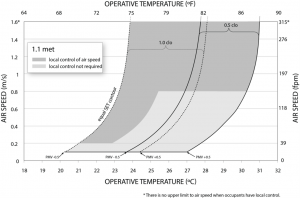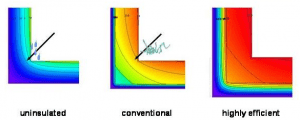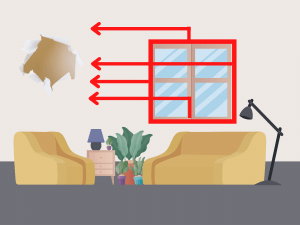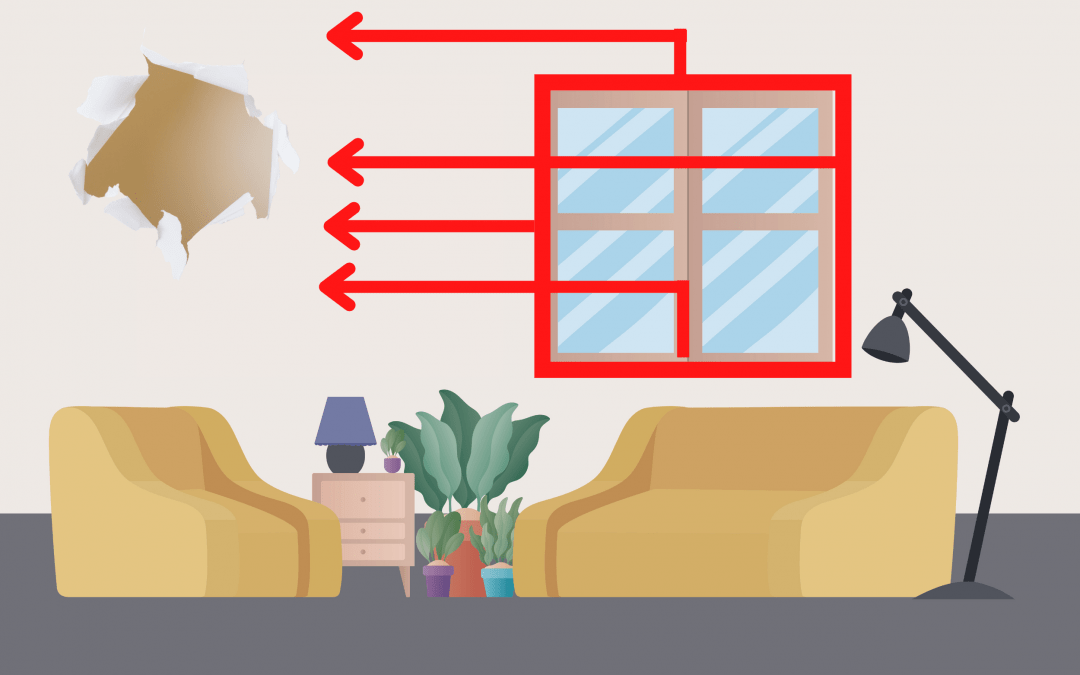Air Speed In The Built Environment
Now that we know how air speed influences our bodies ability to release heat (if not read through our article on airspeed), we can take a look at air speed and its role in the built environment!
We will be focusing on two specific aspects. First, how does air speed in the built environment influence perceived comfort and how do we optimize for it? And how does air speed play a role in energy consumption and what are some best practices for minimizing said consumption.
Comfort
As we know from our article on thermoneutrality our body’s goal is to be in a state of balance, wherein our bodies are able to maintain it’s ideal core temperature 37C whilst the excess heat produced is lost through evaporation, convection, conduction, and radiation without the need for any additional bodily adjustment. The role that air speed plays in this process as we know is that it directly increases or decreases the heat lost from our bodies by these methods. But how does this relate to the built environment?
In a built environment we want to maintain an optimum environment wherein we feel comfortable and at ease. This generally equates to air speeds ranging between .2-.8m/s dependent on the operating temperature (MRT+Air temperature /2) with .2m/s being the maximum in “cold” 23C and below operative temperatures and .8m/s being the maximum in warm 25.5C+ Operative temperatures. (as was found by ASHRAE and indicated in the graph below)

Figure 5-4 Acceptable ranges of operative temperature to and average air speed Va for 1.0 and 0.5 clo comfort zones at humidity ratio 0.010.
However, it should be noted that these values should only serve as reference. Actual results are largely determined on a person-to-person basis with additional variables such as how much clothing is being worn, the metabolism of the individual, as well as current bodily posture also playing a large role. The more dynamic ranges, wherein individual control of the air speed is required to allow for comfort, are indicated by the shaded sections above. These sections largely account for the interpersonal differences beyond air speed affecting our overall thermal comfort. In addition to the comfort element there is also a clear health requirement associated with air speed within the built environment.
Especially in heating scenarios a lot of solutions that heat primarily through forced convection such as central A/C are forced to not only force out air with speeds past the recommended .8m/s (in order to allow for effective heat distribution within the space since the air release ports are usually located on the ceiling), but also dry out the air in the process increasing discomfort. This is in contrast with radiant heating solutions or natural ventilation systems. However, ultimately air speed in the built environment really is a goldilocks scenario with the right middle ground needing to be found since too little air speed is a strong negative as well.
Too little air speed can lead to mold, dust, and pathogens accumulating in the air impacting our health. To best avoid this scenario a minimum .1m/s air speed is generally required to prevent degradation of local air quality, this is also why ultra-insulated houses such as the German Passiv Haus always require an in built ventilation system, since without it the naturally occurring air exchange is inadequate. In contrast too much air speed and we quickly move into thermal discomfort. Additionally, based on The ASHRAE 62.1 (“Ventilation and Acceptable Indoor Air Quality in Residential Buildings”) Its recommended that homes receive no less than 0.35 air changes per hour of outdoor air to ensure adequate indoor air. However, this air change rate can vary drastically depending on the building type, with the requirement even reaching 8 recommended air changes per hour for buildings such as restaurants. This is often determined by the activities taking place in the space as well as overall occupancy levels.
So now we know that in respect to air speed for comfort in the built environment there exists a general range wherein the majority feel comfortable as well as the importance of providing localized control to individuals to account for outliers.
Energy Consumption
The next question is: How does airspeed affect overall energy consumption, and what are some of the most effective ways to reduce energy bills?
For energy consumption it helps to consider two facts. First, that as air speed increases so too does the rate of heat transfer with the surfaces that it meets and second that heat always moves along a gradient flowing from hot to cold. That means that for energy consumption there are two distinct scenarios. A scenario wherein the indoor environment is warmer than the environment outside or a scenario wherein the indoor environment is colder than the environment outside.
Keeping It Warm
In the first scenario the indoor temperature is higher than that outside. Therefore, there is a constant pressure for the warmth inside to gradually move outside until an equilibrium is reached. This process is inexorable but can be slowed down through the improvement of the building’s insulation. The greater the insulation of the space the slower the rate of heat loss. So as a rule in order to minimize the overall energy consumption of your living environment increase the overall insulation level. This can be accomplished by installing outer or inner wall insulation, replacing outdated windows, replacing outdated doors and making sure all are properly sealed. However, since heat will want to follow the path of least resistance that means that any weak points in the insulation of the space will have an outsized effect on the overall energy consumption of the space, since the majority of heat will flow through these thermal bridges.

Heat will always flow along the path of least resistance.
With these bridges functioning essentially like an express lane to the outside. This means to really maximize energy savings during the heating season these thermal bridges need to be taken care of.
But how does this relate to air speed? Mostly through the creation and existence of draughts. A draught or draft can be defined as “a current of air that comes into a place in an undesirable way”. This current of air can occur via two methods: first when there are areas such as windows, doors, and other outlets which are not properly sealed and allow for increased air movement through these unsealed spaces and second when the there is a large temperature difference between the two surfaces leading to greater air velocities being achieved. Both scenarios lead not only to personal discomfort but also drastically increase energy consumption as the rate of heat loss increases, subsequently increasing the amount of heat that needs to be generated in the space to maintain the temperature. Often, people find it hard to imagine how some small cracks/imperfections on their doors and windows may make such a large difference, but the below visual may help. A lot of small holes cumulatively can form the equivalent of a gaping hole.

A lot of small holes can very quickly equal one large one.
To counteract this, we need to make sure to maximize the proper sealing of any surfaces which directly lead to the outdoors, such as windows, doors, and chimneys.
But what about the creation of drafts through surface temperature differences? Functionally, increasing the insulation of any objects facing directly outside, such as windows and doors, will decrease the temperature difference and therefore decrease the resulting increased air speeds. Additionally. relying less on forced air heating solutions whereby the majority of heat can quickly dissipate as the air leaves the space and more on radiative heating solutions which can create lasting surface heat reservoirs may also help to mitigate heat loss.
But what if the goal is to keep the indoor space at a cooler temperature than that outside?
Keep It Cool
In the scenario wherein we want to keep the indoor climate cooler than the outdoor climate air speed is a functional advantage, with the higher air speeds being able to more effectively cool down the spaces. Through intelligent architectural design decision making we can maximize droughts through the building creating an innate cooling system minimizing our reliance on electrical forced air cooling. Alternatively, further insulating the spaces not only makes any localized cooling via A/C more cost effective but can also increase the amount of time required for the space to overheat. However, in a highly insulated space once it has overheated it will take a longer period of time or larger input of cooling energy to reduce the internal temperature.
Air Speed in The Built Environment
Now that we understand how air speed impacts our comfort in the built environment, we can better make intelligent design decisions to control it to get the result we want, and in turn maximize energy savings and comfort.
In the next post in our thermoneutrality series we will be covering the impact that metabolism has on our overall comfort levels.

